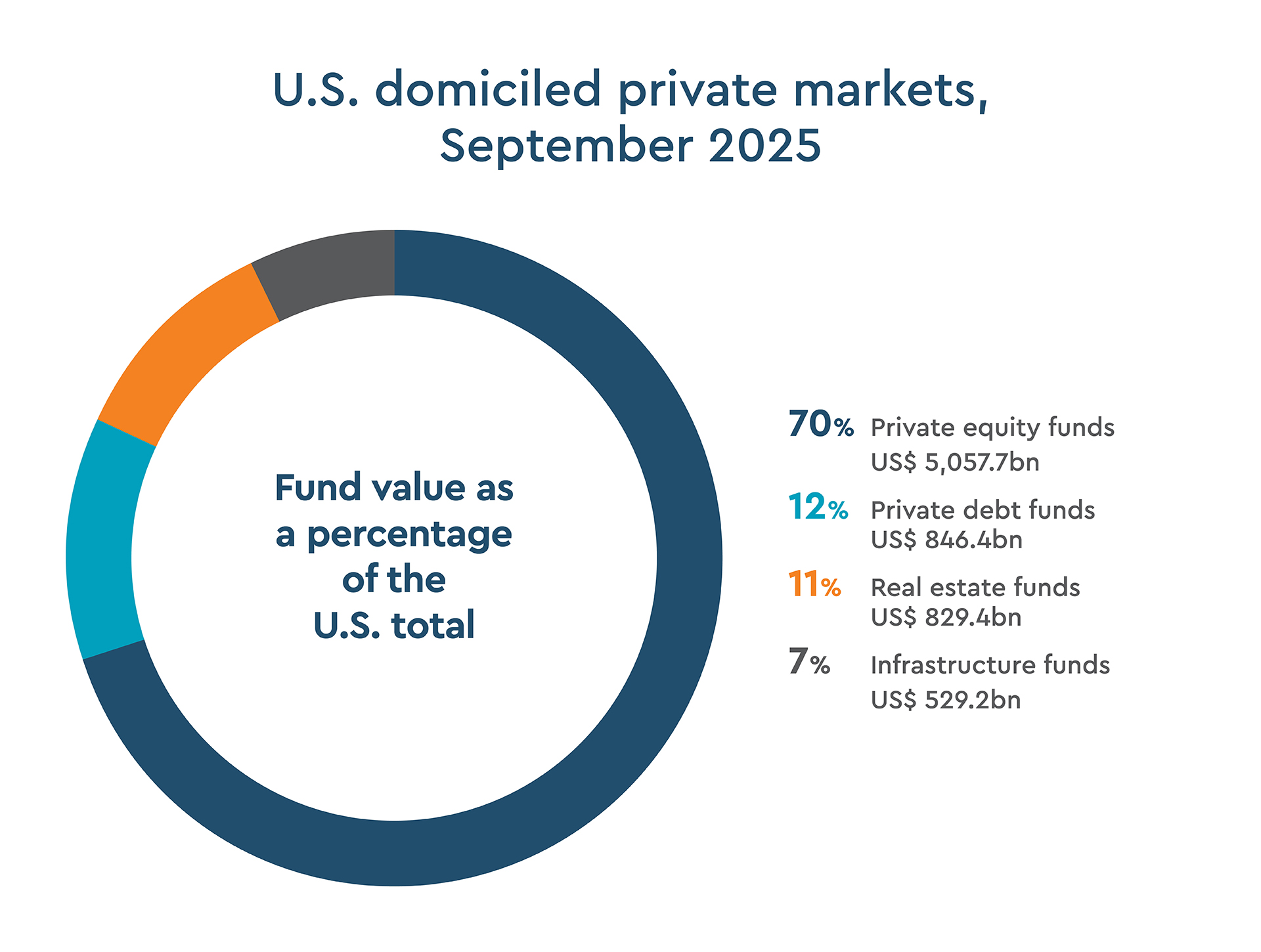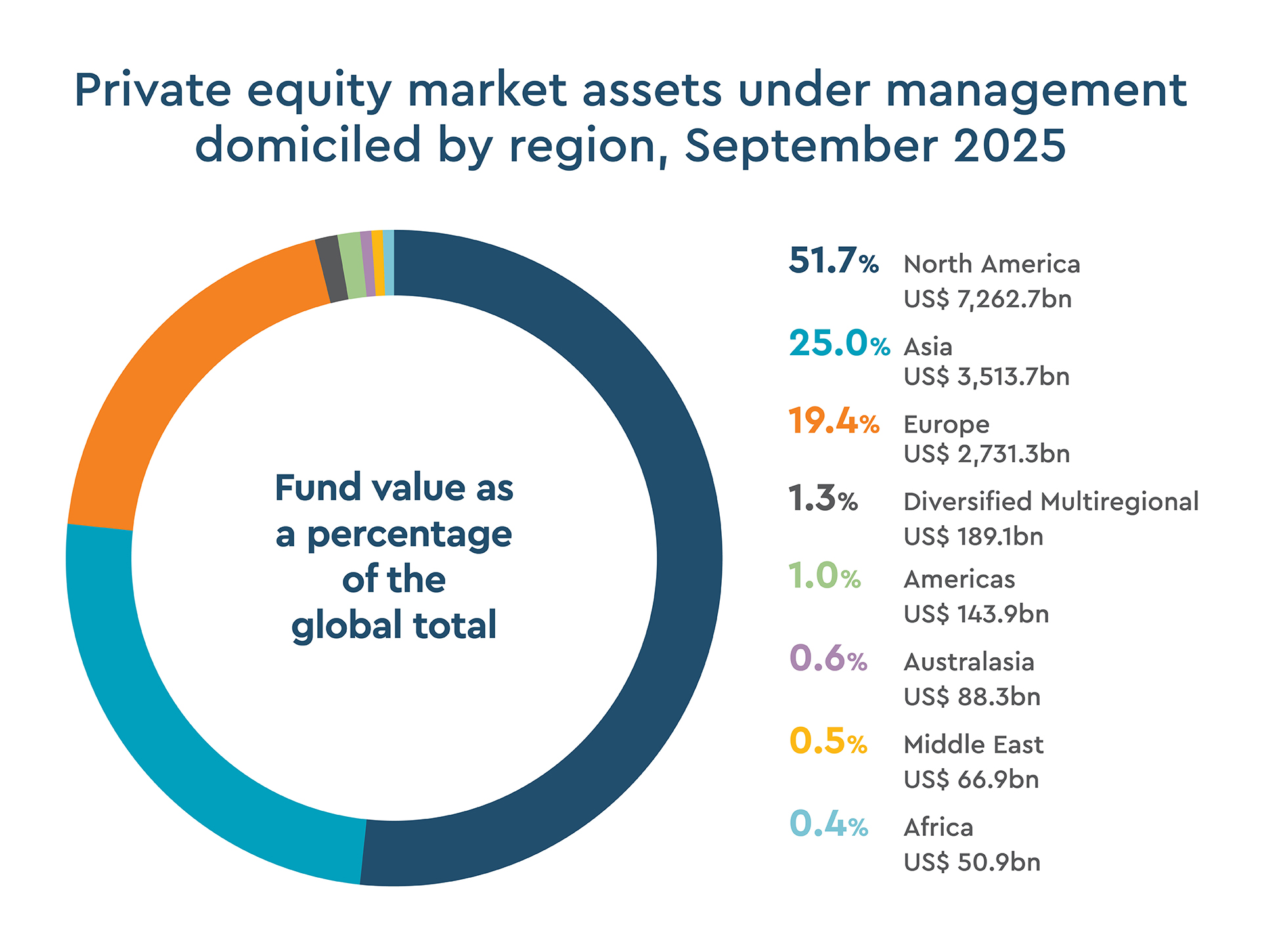
Ocorian’s Global Assets Monitor reveals that U.S. domiciled funds hold over half of private market fund assets globally.
New analysis from Ocorian*, a market leader in asset servicing for private markets and corporate and fiduciary administration, reveals that U.S. based private market funds currently hold around $7.26 trillion in assets under management.
More than half (52%) of global assets in private market funds are in U.S. domiciled funds, Ocorian’s Global Assets Monitor found. This compares to a quarter (25%) in Asia and around a fifth (19%) in Europe.
The total value of assets in U.S. based private markets funds has surged over the last 10 years, rising by over 300% since 2015 when the value was $1.81 trillion and by over 500% since 2009 when it was $1.07 trillion.
Ocorian’s new analysis breaks down how the U.S. domiciled private markets funds are split by type. Out of the $7.26 trillion total, private equity markets make up the lion’s share with $5.06 trillion in assets (70%) followed by private debt at $846 billion (12%), real estate at $829 billion (11%) and infrastructure at $529 billion (7%).

Across private asset classes U.S. private equity remains dominant, infrastructure continues to attract long-duration investors, real estate faces structural headwinds, and private credit is expanding into new frontiers.

Yegor Lanovenko, Global Co-Head of Fund Services at Ocorian said: "While private markets have certainly faced challenges in fundraising, exits and realignment of investment theses given the interest rate, and macroeconomic and geopolitical changes, our analysis predicts its positive growth trajectory will continue over the next five years. The U.S. universe of listed companies has shrunk from over 8,000 stocks in the 1990s to around half of that today, while the number of privately held companies has skyrocketed.
“Private markets retain their structural advantage – the ability to look through short-term volatility and capture durable long-term returns.
“At Ocorian, we help alternative asset managers handle operational and regulatory complexity across the full investment lifecycle, especially when operating scale is a differentiator and investor needs and profiles are evolving fast across asset classes."
About Ocorian
Ocorian is a global leader in fund services, corporate and trust services, capital markets, and regulatory and compliance support.
Unlocking new value for its clients across jurisdictions and service lines is Ocorian’s priority; it manages over 20,000 structures on behalf of 9,000+ clients including financial institutions, large-scale international organisations, and high-net-worth individuals.
Ocorian provides fully compliant, tailored solutions that are individual to clients’ needs, no matter where in the world they hold financial interests, or however they are structured.
The group offers a full suite of corporate, fund and private client services across a network of offices spanning all the world’s financial hubs. Locations include Bermuda, BVI, Cayman, Denmark, Finland, Germany, Guernsey, Hong Kong, Ireland, Isle of Man, Jersey, Luxembourg, Mauritius., Netherlands, Norway, Singapore, Sweden, UAE, the UK, and the U.S.
To find out more about Ocorian and its services, including regulatory information, visit www.ocorian.com
*Methodology
Ocorian commissioned 5iresearch to produce the Global Asset Monitor which considers eight main asset classes that make up the vast bulk of the world’s assets. Four of these are in public markets, namely listed equities and three categories of listed bonds (corporate, sovereign, and other which include municipal and agency bonds). The other four are in private markets, namely private equity, private debt, infrastructure and real estate. We recognise there are other kinds of assets out there in the world, such as residential and commercial property, commodities, art and so on. But we have chosen ours to represent the easily investable universe: investors can buy public assets on exchanges and they can participate in private markets, for example via funds.
Private market data is sourced from Preqin unless otherwise stated, but since this data is only available infrequently and with considerable time lags, we have ‘nowcast’ it by looking at the change in value of relevant public markets since the last Preqin update was released and adjusting the values accordingly. These ‘nowcasts’ are intended only to provide a guide to recent developments.
Public market data is sourced mainly from Factset. Data was captured at market close on September 1st 2025. The equities time series looks at the largest 2,250 companies in the world today and how their market capitalisations have evolved over time. These companies represent 85% of global market capitalisation so we have scaled up by the remaining 15% to show the full global equity market value in each year. To measure the size of the bond markets we have considered both the market value and the face value in each country (and sector in the case of corporate bonds) each year – sourced from Factset. Where data limitations impact the sovereign results, we have derived our figures by Using general government debt levels as a proxy for the bond market.
All data is converted to U.S.D at prevailing spot rates. Currency fluctuations may therefore make an impact in the short term, but over the long-term the effect of exchange rates tends to even out almost entirely at the global level. No account has been taken of inflation.


